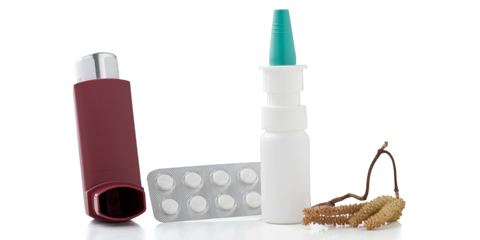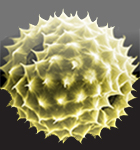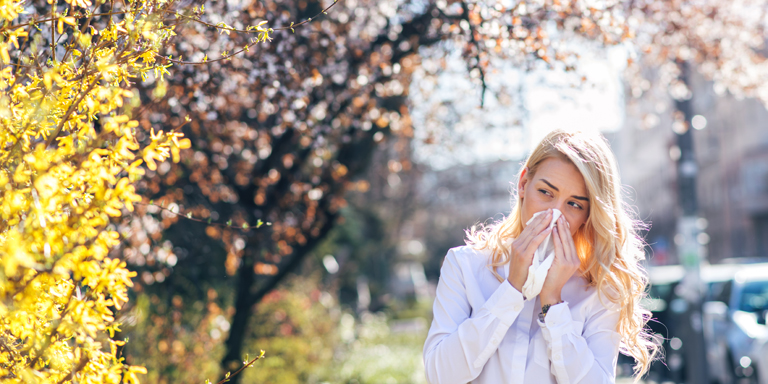Pollen allergy treatment
Various measures can help alleviate the symptoms of pollen allergy.

Table of contents:
There are various pillars of treatment for pollen allergy – depending on the severity of the symptoms. They range from allergen avoidance to drug therapy through to specific immunotherapy. The right treatment can help prevent the allergy from getting worse and developing into asthma.
Allergen avoidance
To prevent or reduce symptoms, it is important to avoid contact with the pollen causing the allergy.
The following tips and tricks can help:
- Get detailed up-to-date information about the pollen count at www.pollenundallergie.ch or on the pollen news app.
- Adapt your outdoor activities accordingly.
- Stay outdoors only for brief periods when pollen levels are high. Indoor sports are suitable for exercise.
- Wear glasses outside.
- During the pollen season, windows should only be briefly opened wide to air rooms. In long spells of rain (over half an hour) or when the windows are fitted with pollen screens, rooms can be aired more generously.
- Fit pollen filters in your car (if not already installed) and keep well maintained.
- Wash your hair before going to bed.
- Do not dry laundry outdoors.
- Do not take off and keep in the bedroom any clothing you have been wearing during the day.
- Avoid any foods to which you have a pollen-associated cross-reaction.
Drug treatment
Various medicines can be used to treat the symptoms of pollen allergy. The most important groups of active substances include antihistamines, corticosteroids (cortisone), leukotriene antagonists and mast cell stabilisers.
Antihistamines block the allergic reaction by ensuring that histamine receptors in the body are occupied and histamine is hence unable to exert its action. Corticosteroids are hormones found in the body and taken as medication, which inhibit the production of inflammatory messengers in the cells. Leukotriene antagonists negate the effect of certain inflammatory messengers (leukotrienes). Mast cell stabilisers ensure that the mast cells do not release any inflammatory messengers.
To ensure that the pollen allergy symptoms can be successfully overcome, it is essential to discuss the treatment in detail with the treating doctor.
It is recommended to begin drug treatment a few days before the start of the pollen season and to continue treatment until no more allergy-triggering pollen are in the air.
The following forms of medication can be used:
Eye drops
Eye drops are used to treat red, itchy and streaming eyes (allergic conjunctivitis). The eye drops may contain active substances from the group of antihistamines or mast cell stabilisers. As eye drops are applied locally and act only where applied, side effects are unlikely.
Nasal spray
A runny, blocked or itchy nose (allergic rhinitis or rhinitis) can be treated with a nasal spray. Nasal sprays containing corticosteroids, antihistamines or a combination product (antihistamine and corticosteroid) are used to relieve the symptoms. An improvement in the allergic rhinitis may also have a positive effect on the eyes. Nasal sprays act locally where the symptoms occur. This is why they are unlikely to have any side effects.
Tablets
Tablets containing antihistamines or leukotriene antagonists and, in severe cases, corticosteroids can also be taken to treat the symptoms of pollen allergy (allergic rhinitis, allergic conjunctivitis). Any side effects that may occur should be discussed with the treating doctor.
Drops
Drops are taken like tablets in order to treat the symptoms of pollen allergy (e.g. itching in the roof of the mouth, nose and ears, runny nose). The drops contain active substances from the group of antihistamines and in Switzerland they are mainly used for children.
Medication for asthma
Breathing symptoms may also sometimes occur that are due to allergic asthma. For effective treatment, inhalation medication with corticosteroids and bronchodilators should be used. Their use and any possible side effects should be discussed with the doctor.
Fighting the causes – allergen-specific immunotherapy
Allergen-specific immunotherapy (desensitisation) is the only causal treatment for pollen allergy. It involves injecting pollen allergens under the skin (subcutaneous administration; SCIT) or taking them as tablets or drops under the tongue (sublingual administration; SLIT) in increasing doses over three to five years. The aim is to get the body slowly used to the allergen and thereby build up immunological protection that will reduce or even prevent further allergic reactions. When successful, immunotherapy can achieve a reduction or even complete absence of symptoms.
The information above is no substitute for a visit to the doctor.
Editors: aha! Swiss Allergy Centre in co-operation with the Scientific Advisory Board.




